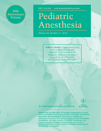Slower administration of propofol preserves adequate respiration in children
Summary
Background: Propofol is a versatile anesthetic agent used in pediatric practice to facilitate investigational and interventional procedures. Propofol can cause significant respiratory depression, the management of which may require advanced airway management skills. This investigation aimed to increase the safety of propofol administration by developing a dosing schedule that would preserve spontaneous respiration in at least 95% of subjects.
Methods: With Research Ethics Board approval and informed consent, American Society of Anesthesiologists’ Status I and II children aged 6–15 years presenting for upper or lower gastrointestinal endoscopy were enrolled. An intravenous loading dose of propofol (4 mg·kg−1) was administered at a rate determined by a randomization schedule in a two-phased study. Following the loading dose, additional propofol was infused at 200 mcg·kg−1·min−1 for 5 min or until respiratory insufficiency was observed. In Phase I, the infusion rate was modified by 100 mcg·kg−1·min−1 increments depending upon the respiratory response of the previous subject. In Phase II, the duration of infusion was randomized according to a Biased Coin Design principle to determine the 95% threshold for respiratory insufficiency.
Results: Fifty subjects were included in the analysis. Infusion rates ranged from 1000 to 2300 mcg·kg−1·min−1. Seven subjects experienced respiratory insufficiency. The mean (sd) time to respiratory insufficiency was 104 (36) s and duration was 93 (51) s. A propofol loading dose administered over 3.0 min (CI = 1.9–3.4 min) maintained spontaneous respiration in 95% of subjects.
Conclusions: The respiratory response to propofol is highly variable in children. Slower infusion of propofol will result in a lower risk of respiratory depression.




